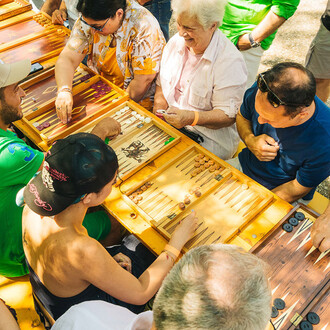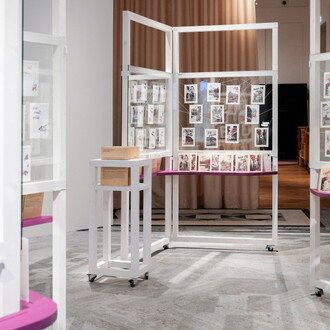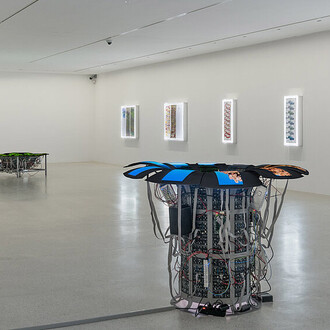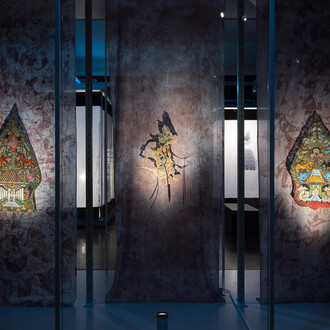Even though the Asia Department was established only 70 years ago, the MAK (formerly the Imperial and Royal Austrian Museum of Art and Industry) has, since its inception, possessed competency in the field of Asian arts and crafts, since it is and always has been impossible to represent European material history without making reference to works from Asia. By the year 1900, the MAK already owned an impressive collection documenting highlights from Asian cultures. The cornerstone for today’s overwhelmingly dimensioned Asia Collection was laid in 1907 with the takeover of the rich holdings of the former Imperial and Royal Austrian Museum of Trade. It was at that point in time that the extensive Japan Collection of Heinrich Siebold, as well, entered the MAK’s possession (then: Imperial and Royal Austrian Museum of Art and Industry)—he had donated it to the Museum of Trade in 1892.
Chinese porcelain, Japanese lacquer works, Japanese colored woodcuts (ukiyo-e) and Japanese printing stencils (katagami) are the central focuses of today’s Asia Collection.
The most important part of the collection—Chinese and Japanese ceramics and porcelain—contains extremely fine examples from various eras representing the richness of variation in East Asian ceramics from their beginnings onward. The focal point of these holdings corresponds to the golden era of this art form, which began in the 18th century. The most precious works represented in this segment of the collection include an early blue-and-white plate from the Yuan dynasty (1271–1368), tea ceramics from China and Japan, Chinese Kangxi-period porcelain (1666–1722) from the collection of August the Strong, and a porcelain painting showing Mount Fuji by Japanese artist Kawamoto Masukichi (1831–1907), a gift of the Japanese government to the museum following the Vienna World’s Fair of 1873.
The collection of high-quality Japanese lacquer works includes objects from as far back as the early 17th century and is particularly rich in examples from the Meiji period (1868–1912). Among this collection’s most outstanding objects is a fan-shaped lacquer painting by Ikeda Taishin (1829–1903).
The katagami collection of the MAK, at 10,000 objects, is one of the largest such collections worldwide. It provides an impressive overview of the production, coloring techniques and ornamental history of the katagami stencil, which since the 7th century has been regarded by the Japanese as a respected artisan tool for coloring leather, cloth and paper. A full 8,000 of the Japanese stencils collected here were part of Heinrich Siebold’s donation to the Imperial and Royal Austrian Trade Museum, which holdings passed into the ownership of the Austrian Museum for Art and Industry, today’s MAK, in 1907.
At around 4,200 pages, the collection of Japanese colored woodcuts is one of Europe’s major ukiyo-e collections and also one of the larger collection blocks at the MAK. The lion’s share of these works comes from private collections which entered the museum in the most diverse ways, including the collections of Anton Exner, Richard Lieben and Heinrich Siebold. The ukiyo-e collection of the MAK brings together works by around 200 artists from the late 17th to the early 20th century, including icons of Japanese art such as the landscape series 36 Views of Mount Fuji (Japan, ca. 1830) by Katsushika Hokusai (1760–1849) and pages from the series 100 Famous Views of Edo (1857) by Ando Hiroshige (1797–1858), which were of central importance to the development of European modernism.
Based on the hypothesis that Japanese comics—mangas—influence the development of today’s visual culture in a way similar to how ukiyo-e once did, the MAK Asia Collection is currently working on putting together a manga collection with the intent of using exemplary works to document the visual aesthetics of this mass phenomenon.
The museum presentation of the most outstanding objects of the Asia Collection, is since 2014 in a fundamentally new way. Selected artefacts from the collection are embedded in an artistic concept and design created specifically for the venue by the renowned artist Tadashi Kawamata, yielding profound insight into the art and cultures of East Asia. The MAK Permanent Collection ASIA: China – Japan – Korea is put on show on the ground floor of the museum, based in Kawamata's concept on permanent change and the play of light and shade.
















